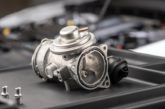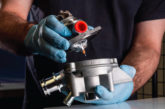
The movement towards reduced emissions has no doubt had a positive effect on global air quality. According to the Manufacturers of Emission Controls Association (MECA), catalytic converters, for example, have reduced emissions by 10 billion tonnes in the US alone since their introduction in the mid-1970s. However, the mainstream use of catalytic converters has also birthed a new breed of crime: catalytic converter theft.
The catalytic converter reduces harmful emissions by converting toxic gases into less harmful ones within internal combustion engines. The modern converter sees the particular reduction of NOx emissions, which cause smog and poor air quality.
London Metropolitan Police has witnessed a rapid increase in catalytic converter theft: the first six months of 2019 saw a staggering 73% increase in the crime compared to the whole of 2018, and this number is expected to continue to rise as we enter 2020. But what makes these components so alluring to thieves?
All that glitters is gold
The internal chemistry of the component uses precious metals such as palladium, rhodium, and platinum as the primary catalysts, and the value of these has grown significantly within the past 18 months.
Ironically, one of the reasons for the sudden value increase of these metals is due to the demand from vehicle manufacturers, who are looking to produce catalytic converters themselves. According to metals merchant FJ Church and Sons, rhodium is currently worth £4,190 per ounce, and the value of platinum stands at approximately £700 per ounce. A converter can contain up to 7g of platinum, meaning that thieves can potentially make a profit of up to £175 from the platinum alone, depending on purity and extraction yield.
Thieves also tend to target hybrid vehicles rather than those with combustion engines. This is due to the fact that hybrid vehicles process fewer emissions than traditional engines and have less to convert due to their partially electric power source, meaning that the catalysts in the converter are purer and therefore more valuable. Since the catalytic converter is installed externally and close to the engine, it is also easy for thieves to locate and remove, using high power tools to remove the component in just minutes.
The prevalence of the crime has been well documented, and it’s worth considering that the risk and potential additional costs might deter prospective buyers of hybrid vehicles. With EVs and HVs making up just 3.8% of the total UK car parc, the electric revolution has a long way to go. With the average cost of EVs and HVs still being more expensive to initially buy than the traditional combustion engine vehicle, there is a greater need for an incentive to make the switch to electric.
While some measures have been taken by VMs, there’s still plenty of work to be done to fully combat the converter theft issue. There appears to be a lack of governmental response, and scrap dealers are urging for legislation that makes it illegal to pay cash for scrap parts, which would decrease the number of thefts by creating a paper trail that would inevitably lead back to the thieves.
Sage Advice
Despite this crime being on the rise, there are a number of strategies to avoid becoming a victim of catalytic converter theft. These methods are endorsed by the London Metropolitan Police, and may be invaluable to your customers.
Property marking
Etching a catalytic converter with a serial number will help police track a stolen converter to a specific injured party. Obvious property marking may also deter thieves, as it makes it more difficult to sell to reputable scrap metal dealers, and easier to track back to them.
Welded bolts
If the catalytic converter is a ‘bolt on’ type, it’s possible to have the bolts welded shut. This may only deter low grade thieves who are working with weaker tools, but may still act as a decent deterrent.
Catalytic converter protective sleeves
Companies such as CatClamp offer catalytic converter locks. These can be expensive, with the newest model costing up to £350, but pale in comparison to the £1,000 fine that faces vehicle owners without converters. VMs are also beginning to offer these devices; Toyota, for example, offers the Catloc, which is priced between £200 and £250, including fitting.
Defensive parking
Parking up against walls blocks access to the underneath of the vehicle, and can be a good deterrent for a thief looking for a quick and easy job. This lack of access would at least slow them down, making them a less attractive target. This may be aided by the fact that VMs are beginning to take measures to deter theft with the positioning of the component. Honda, for example, has fitted Accord and Jazz models from 2008 onwards with a tray under the car, to make it harder for thieves to access the converter.
CCTV/alarms
Investing in driveway alarms is also recommended, as they monitor in real time and can alert the police as well as the vehicle owner.









